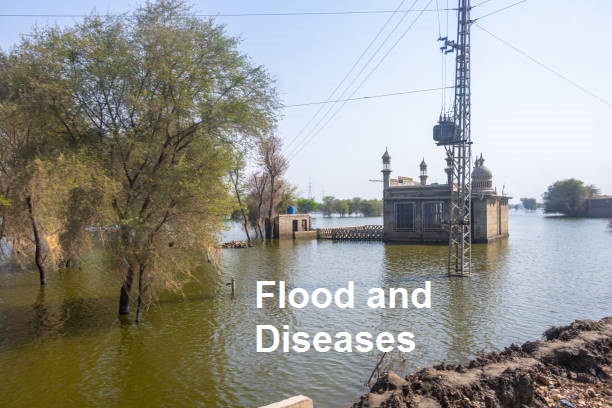Introduction
Flood in Pakistan has once again brought with it a wave of destruction—not just in infrastructure but also in public health. As floodwaters inundate cities and rural communities, they leave behind stagnant water, contaminated supplies, and a breeding ground for a multitude of diseases. The health risks are not only immediate but can persist for weeks and months. In this blog, we will cover the top 10 diseases that spread after floods and practical preventive measures to safeguard yourself and your family.
1. Cholera
Cholera is a life-threatening diarrheal illness caused by ingesting contaminated water or food. The bacteria Vibrio cholera multiply rapidly in stagnant floodwaters.
Symptoms:
Severe watery diarrhea
Dehydration
Muscle cramps
Rapid heart rate
Prevention:
Drink only boiled or bottled water
Use ORS (Oral Rehydration Solution) at the first sign of diarrhea
Ensure proper sanitation and hygiene when handling food
2. Hepatitis A and E
Outbreaks of Hepatitis A and E are common after floods due to contamination of water sources with fecal matter. Both viruses cause inflammation of the liver.
Symptoms:
Jaundice
Fatigue
Nausea and vomiting
Dark urine
Prevention:
Avoid drinking untreated water
Wash hands thoroughly with soap after using the toilet
Avoid raw or undercooked foods during flood periods
3. Typhoid Fever
Typhoid, caused by Salmonella typhi, spreads through ingestion of food and water contaminated by human waste. The risk significantly rises after the flood in Pakistan due to poor waste disposal.
Symptoms:
High fever
Abdominal pain
Constipation or diarrhea
Rash (rose spots)
Prevention:
Drink chlorinated or boiled water
Get vaccinated if living in flood-prone regions
Practice strict hand hygiene
4. Leptospirosis
Leptospirosis is a bacterial infection that spreads through contact with floodwater contaminated with the urine of infected animals. Walking barefoot or wading through water increases risk.
Symptoms:
Fever and chills
Muscle aches, especially in calves
Red eyes
Vomiting
Prevention:
Wear protective boots and gloves when exposed to floodwater
Avoid swimming or bathing in flood-affected areas
Disinfect wounds immediately
5. Diarrheal Diseases
Diarrhea is one of the most widespread illnesses after floods, particularly among children. It can result from drinking dirty water or consuming unhygienic food.
Symptoms:
Frequent loose stools
Abdominal cramping
Dehydration
Weakness
Prevention:
Use ORS and zinc supplements
Maintain food hygiene
Boil water before consumption.
6. Malaria
Stacked water due to flooding acts as an excellent breeding ground for Anopheles mosquitoes, the vector of malaria.
Symptoms:
- Cyclic high fever
- Feeling chills and sweating.
- Headache
- Vomiting
Prevention:
- Use mosquito nets and repellents.
- Eliminate standing water around your home.
- Spray insecticides in residential areas.
7. Dengue fever
Dengue, spread by Aedes aegypti mosquitoes, thrives in stagnant, clean water after flooding in containers, tires and open tanks.
Symptoms:
- High fever
- Severe body aches (fever bone)
- Skin rash
- Bleeding from the nose or gums.
Prevention:
- Empty all containers with standing water.
- Wear long sleeves and pants.
- Use mosquito repellent daily.
8. Skin infections and fungal diseases
Continuous exposure to dirty and contaminated water can lead to skin problems such as dermatitis, cellulitis and fungal infections.

Symptoms:
- Itchy or scaly skin
- Redness and inflammation
- Pus-filled blisters.
- Foul odor
Prevention:
- Keep skin dry and clean
- Avoid wearing wet clothes for long periods of time.
- Apply antifungal powder or cream as needed.
9. Respiratory tract infections
Floods often lead to overcrowding in relief camps, which makes respiratory infections such as pneumonia, bronchitis and influenza spread rapidly.
Symptoms:
- Cough and congestion
- Difficulty breathing
- Fever
- Chest pain
Prevention:
- Avoid close contact with infected people
- Maintain good ventilation
- Wear face masks in shelters or camps.
10. Snake and insect bites
Floodwater carries snakes, scorpions, and insects into human settlements, increasing the risk of dangerous bites and stings.
Symptoms:
- Bite marks or puncture wounds
- Swelling and sores
- Difficulty breathing (in severe cases)
- Dizziness.
Prevention:
- Shake clothing and bedding before use.
- Use a flashlight at night.
- Seek immediate medical attention for any bites.
Conclusion
Be vigilant, be safe
Flood in Pakistan may be less frequent, but the health risks it poses can be just as deadly. Recognizing symptoms early and taking precautions can significantly reduce the risk of disease. As a community, we must emphasize hygiene, access to clean water, and health education to prevent outbreaks and protect vulnerable populations.
If you found this article useful, please share it to raise awareness in flood-affected areas.
FAQS
No, tap water may be contaminated after a flood. Always drink boiled, filtered, or bottled water during and after flood conditions.
Begin oral rehydration therapy (ORS) immediately, drink safe fluids, avoid raw food, and consult a doctor as soon as possible to prevent dehydration or complications.
It is recommended to get vaccinated for typhoid, hepatitis A, tetanus, and cholera, especially if you live in or near flood-affected areas.


Leave a Reply